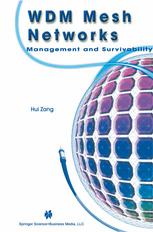

Most ebook files are in PDF format, so you can easily read them using various software such as Foxit Reader or directly on the Google Chrome browser.
Some ebook files are released by publishers in other formats such as .awz, .mobi, .epub, .fb2, etc. You may need to install specific software to read these formats on mobile/PC, such as Calibre.
Please read the tutorial at this link: https://ebookbell.com/faq
We offer FREE conversion to the popular formats you request; however, this may take some time. Therefore, right after payment, please email us, and we will try to provide the service as quickly as possible.
For some exceptional file formats or broken links (if any), please refrain from opening any disputes. Instead, email us first, and we will try to assist within a maximum of 6 hours.
EbookBell Team

4.4
42 reviewsIn recent years, with the rapid growth of the Internet, the bandwidth demand for data traffic is exploding. Optical networks based on wavelength-division multiplexing (WDM) technology offer the promise to satisfy the bandwidth requirements of the Internet infrastructure. With WDM technology, signals are carried simultaneously on mUltiple wavelengths on a single fiber. WDM provides a practical approach of resolving the mismatch between the fiber ca pacity and the peak electronic processing speed. Mesh-based WDM networks have recently attracted much research and development interest since the In ternet topology is meshed in nature, and more importantly, mesh-based WDM networks are flexible with respect to routing and survivability. This book exam ines the management and survivability issues of mesh-based WDM networks and proposes new WDM network protocols and algorithms that could make telecommunication networks more efficient. Wavelength-routing has been one of the most important technologies to em ploy WDM in backbone networks. In wavelength-routed WDM networks, optical channels, which are referred to as lightpaths, are set up between WDM terminals. Most chapters of this bock are focused on various issues related to wavelength-routed networks, namely, routing and wavelength-assignment, con trol and management, fault management, and wavelength-converter placement. This book also presents an all-optical packet-switched network architecture based on the concept of photonic slot routing. The audience for this book are network designers and planners, research and development engineers active in the field of telecommunications, and students of optical networking at the graduate or senior undergraduate levels.